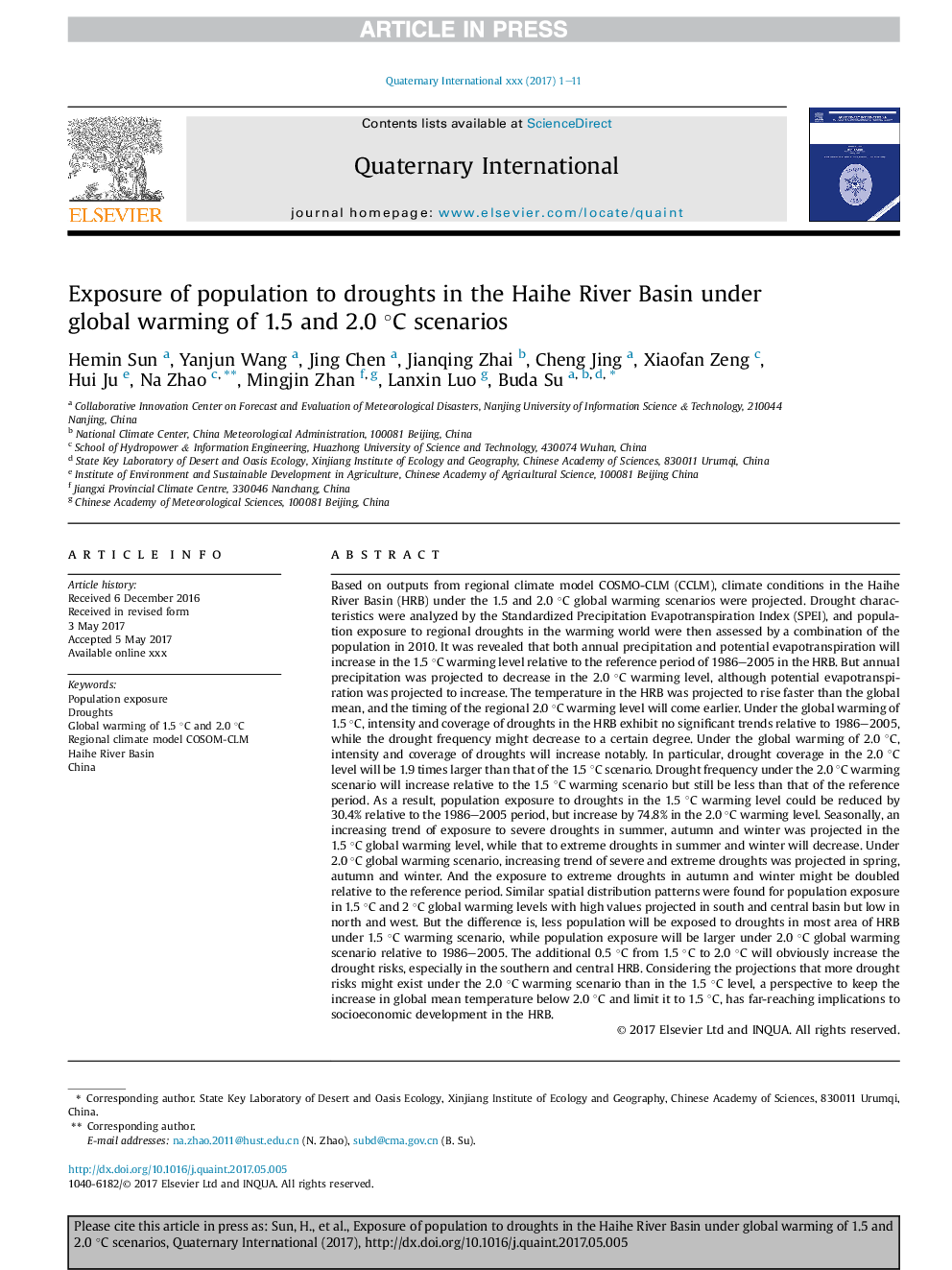| کد مقاله | کد نشریه | سال انتشار | مقاله انگلیسی | نسخه تمام متن |
|---|---|---|---|---|
| 5113098 | 1484070 | 2017 | 11 صفحه PDF | دانلود رایگان |
عنوان انگلیسی مقاله ISI
Exposure of population to droughts in the Haihe River Basin under global warming of 1.5 and 2.0 °C scenarios
دانلود مقاله + سفارش ترجمه
دانلود مقاله ISI انگلیسی
رایگان برای ایرانیان
کلمات کلیدی
موضوعات مرتبط
مهندسی و علوم پایه
علوم زمین و سیارات
زمین شناسی
پیش نمایش صفحه اول مقاله

چکیده انگلیسی
Based on outputs from regional climate model COSMO-CLM (CCLM), climate conditions in the Haihe River Basin (HRB) under the 1.5 and 2.0 °C global warming scenarios were projected. Drought characteristics were analyzed by the Standardized Precipitation Evapotranspiration Index (SPEI), and population exposure to regional droughts in the warming world were then assessed by a combination of the population in 2010. It was revealed that both annual precipitation and potential evapotranspiration will increase in the 1.5 °C warming level relative to the reference period of 1986-2005 in the HRB. But annual precipitation was projected to decrease in the 2.0 °C warming level, although potential evapotranspiration was projected to increase. The temperature in the HRB was projected to rise faster than the global mean, and the timing of the regional 2.0 °C warming level will come earlier. Under the global warming of 1.5 °C, intensity and coverage of droughts in the HRB exhibit no significant trends relative to 1986-2005, while the drought frequency might decrease to a certain degree. Under the global warming of 2.0 °C, intensity and coverage of droughts will increase notably. In particular, drought coverage in the 2.0 °C level will be 1.9 times larger than that of the 1.5 °C scenario. Drought frequency under the 2.0 °C warming scenario will increase relative to the 1.5 °C warming scenario but still be less than that of the reference period. As a result, population exposure to droughts in the 1.5 °C warming level could be reduced by 30.4% relative to the 1986-2005 period, but increase by 74.8% in the 2.0 °C warming level. Seasonally, an increasing trend of exposure to severe droughts in summer, autumn and winter was projected in the 1.5 °C global warming level, while that to extreme droughts in summer and winter will decrease. Under 2.0 °C global warming scenario, increasing trend of severe and extreme droughts was projected in spring, autumn and winter. And the exposure to extreme droughts in autumn and winter might be doubled relative to the reference period. Similar spatial distribution patterns were found for population exposure in 1.5 °C and 2 °C global warming levels with high values projected in south and central basin but low in north and west. But the difference is, less population will be exposed to droughts in most area of HRB under 1.5 °C warming scenario, while population exposure will be larger under 2.0 °C global warming scenario relative to 1986-2005. The additional 0.5 °C from 1.5 °C to 2.0 °C will obviously increase the drought risks, especially in the southern and central HRB. Considering the projections that more drought risks might exist under the 2.0 °C warming scenario than in the 1.5 °C level, a perspective to keep the increase in global mean temperature below 2.0 °C and limit it to 1.5 °C, has far-reaching implications to socioeconomic development in the HRB.
ناشر
Database: Elsevier - ScienceDirect (ساینس دایرکت)
Journal: Quaternary International - Volume 453, 25 September 2017, Pages 74-84
Journal: Quaternary International - Volume 453, 25 September 2017, Pages 74-84
نویسندگان
Hemin Sun, Yanjun Wang, Jing Chen, Jianqing Zhai, Cheng Jing, Xiaofan Zeng, Hui Ju, Na Zhao, Mingjin Zhan, Lanxin Luo, Buda Su,